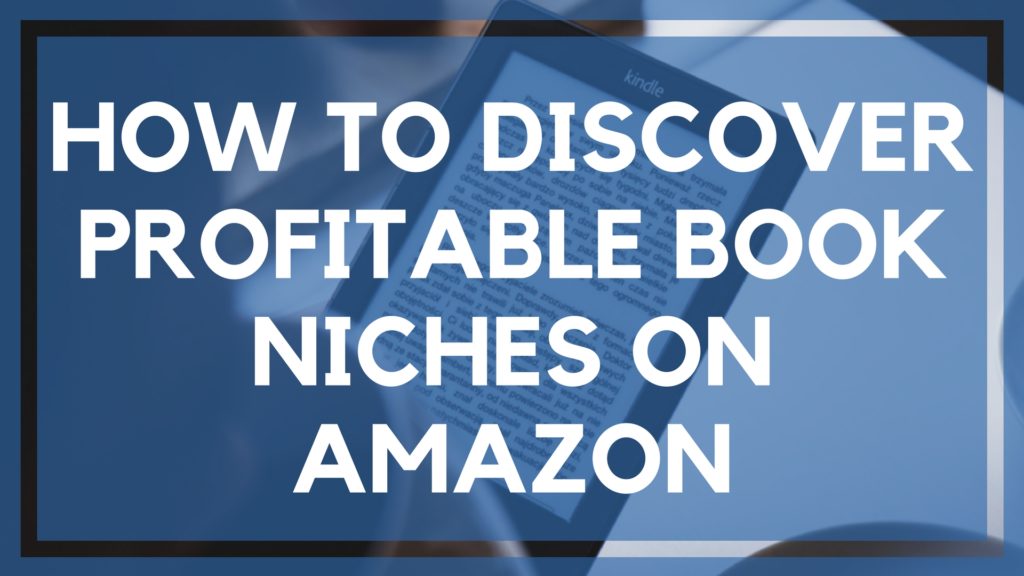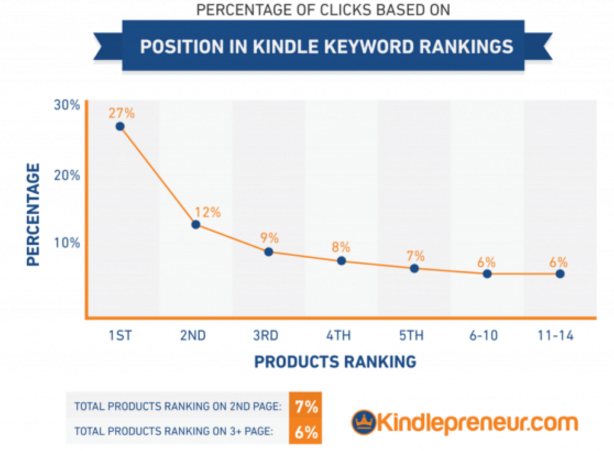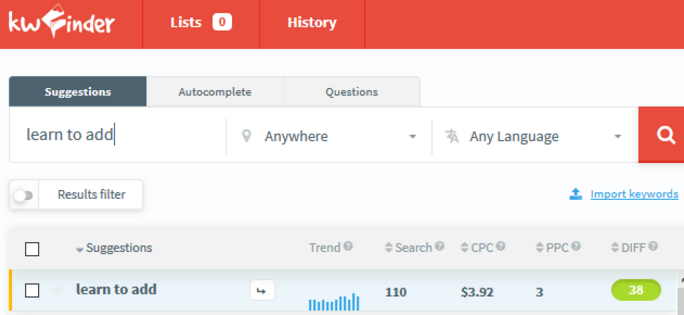Note from Sean: Dave Chesson is the man when it comes to understanding self-publishing and Kindle book niches. So there was no better person to write this post.
Looking to find profitable book niches on Amazon? Look no further! Take it away, Dave.
—
Self-publishing is an authentic opportunity to generate life-changing passive income no matter where you are in the world.
What makes self-
Books are never going away.
People love to read and the worldwide eBook market is growing and expanding all the time. This isn’t a flash in the pan trend that you invest your time and money into only to witness a rapid decline at some stage.
Creating a book is also something which is possible for absolutely everyone. Even if writing doesn’t appeal to you, you can easily outsource every step of the process without any special technical skill or knowledge.
Releasing books also adds genuine value to the world. If your books are successful, they are solving people’s problems, or entertaining them. Isn’t that something to feel good about?
Like any business opportunity, self-publishing needs to be done the right way.
Too many newcomers get caught up in the excitement of envisioning their future publishing empire and rush into releasing a book without a proper process of research and development.
When the book fails, they turn their back on self-publishing.
To avoid the pain of future failure, and to safeguard your precious time from a project which was doomed from the start, you need to research and validate your book idea ahead of time.
In this post, I’m going to show you the exact steps you need to carry out to discover if your book idea is worth pursuing.
This process is perfect for new authors who are dipping their toes into the water for the first time and don’t have the experience and success to fall back on. It also works for more experienced publishers who wish to fine tune their efforts for their next project.
It’s by no means a magic bullet or a get-rich-quick process. Far from it.
However, it does guarantee you the peace of mind of working on a project with a great chance of success.
It’s a lot easier to invest your time and energy into something you have validated, through hard data, as being likely to succeed.
Here’s how it’s done.
What Does A Profitable Book Idea Look Like?
The focus of this post will be discovering book topics that have the potential to make real money on Amazon.
Amazon is the largest shopping search engine on the planet. If you find an idea that is right for Amazon, it’s right for other retailers as well.
The basic concept underpinning success on Amazon is similar to success on Google. On Google, website owners aim to appear high on the search results page for terms that people are searching for. The vast majority of the traffic goes to the top results.
Amazon is similar. People visit the site and search for terms related to their area of interest.
They are then presented with a list of results, in the form of products available to buy.
Just as the lion’s share of traffic on Google goes to the top results, the majority of searchers on Amazon will check out the first result shown to them.
In fact, if you rank #1 on Amazon for any given search term, you can expect to enjoy 27% of the traffic for that search term. If you rank #2, this drops down to 13%.
It goes without saying that not everyone who searches for your book will buy it. However, unless people discover your book, there is a 0% chance of a sale occurring. Ranking highly in Amazon’s search results is one of the quickest ways to put your book in front of the eyes of eager buyers.
Three Keys to a Profitable Idea
The importance of ranking well on Amazon is clear. But what exactly should you aim to rank for?
There are three components to a profitable book idea:
- Active demand for your idea on Amazon
- Customers willing to spend money on your idea
- The competition for your idea is beatable
Let’s look at each one a little more in-depth.
Is There Active Demand in Your Kindle Niche?
The first piece of the puzzle, active demand for your idea on Amazon, stops you from writing a book that only you would want to read. It’s great to work on something you care for and are passionate about, but it’s important that others feel the same way as well.
Are There Customers Who Will Pay
The second ensures that people are actually willing to pay money for the information you offer them. There are plenty of topics which people are interested in, but not willing to spend money on, as their needs can be met for free.
Is Their Beatable Competition
The final criteria ensures that you have a shot at competing. There are plenty of ideas out there with lots of paid demand, but this demand is already met by great quality books with hundreds of favorable reviews.
There is no point in competing in such a scenario. Instead, step three allows you to intelligently assess weaknesses in the competition and determine your own book’s strategy for competitive advantage.
Now you know the three qualities of a profitable book niche idea, let me show you exactly how to find one.
Note: Prefer to do a blog over a book? Try this step by step guide for building a niche site.
Join over 40,000 people who have taken our 6 part freelance writing course. Sign up below and let’s do this together.
By entering your email address you agree to receive emails from Location Rebel. We'll respect your privacy and you can unsubscribe at any time.
Step By Step Guide To Finding A Profitable Book Idea
The following steps allow you to explore your book ideas until you find one which satisfies the three criteria outlined above.
What are people searching for?
The initial step in the process is finding whether people are actively looking for information relating to your book idea. There are three ways you can ascertain this.
The first way to figure out whether people are searching for your idea is to turn to Amazon itself.
The suggestions feature on Amazon is a good starting point. You may have come across this idea in another recent Location Rebel post on Kindle publishing. I have my own slight twist on the concept.
I like to put a broad term into the search bar, but rather than just focusing on what Amazon suggests, I add the letters of the alphabet, one by one, after the search term. This allows Amazon to suggest a wider range of ideas than would be the case if you only input your broader search term.
For example, type ‘Learn to a’ followed by ‘Learn to b’ and so forth.
By following this method, you come up with a list of ideas that you know there’s at least some demand for on Amazon.
The problem is, you have no idea how much demand there is for a particular book niche. Amazon only suggests terms but doesn’t tell you how much demand exists for each term.
To get a feel for the relative levels of demand for each term, I like to turn to Google. If people are interested in an idea on Google, there is every chance that this demand carries over to Amazon.
To check out the Google demand for an idea, check out KWFinder. You can plug your ideas in and see how much demand there is for each one relatively.
Once you’ve found an idea and validated that people are interested in it, it’s time to make sure that people are willing to spend money on it.
Are people paying in this Kindle niche?
To assess whether people are willing to pay money for an idea, we need to go back to Amazon and use their metrics to assess how much money is currently being generated by your book ideas.
This is a six-step process:
Step 1: Take an idea phrase that you’ve already determined the Google demand for. Input it into the Kindle store search.
Step 2: Open the top 14 books that rank for your term in new tabs. Scroll down until you reach their Amazon Best Sellers Rank, known as ABSR. This is a measure of how well a book is doing recently relative to other books.
Step 3: Plug each ABSR into the free Kindle Best Seller Calculator. This will convert an ABSR into an accurate estimate of the number of books sold per day.
Step 4: The number of books sold per day allows you to figure out how much money is being made. Multiply the daily sales figure by the price of the book. Then, multiply this figure by 0.7 for books retailing between $2.99 and $9.99 and 0.3 for all other prices.
This takes into account the cut Amazon takes so that you are left with only the income received by the author.
For example, if you had a book selling at $4 that sold 28 copies per day, you would carry out $4 x 28 = $112. Then you have to take out Amazon’s fee, so it would be $112 x 0.7 = $78.4.
You know that after Amazon’s cut of the cake, the author is making an average of $78.40 for that book per day.
Step 5: Do the above for all of the top 14 books for the idea you are researching. Add up the total net daily income per book and divide by 14. This will give you an idea of the average income for the books that rank for your idea.
Step 6: If the amount of money you could potentially make from your book idea, based on the above calculations, is acceptable to you, then proceed to the next stage of the process.
If not, keep playing around with ideas on Amazon and KWFinder until you find one with sufficient levels of paid demand.
What’s the competitive situation?
It’s now time to see if your profitable, in-demand book idea is one which you stand a chance of succeeding with. This requires a mix of quantitative and qualitative analysis as well as intuition.
Here are things to consider:
1. What’s the ABSR for the top 10 books? If the majority of the top 10 are ranking at #30,000 or lower, then it will take a lot of effort to go up against the current competition.
2. If your specific book idea keyword is showing up consistently in the title and subtitle, it will be difficult to rank.
3. Are the book covers for competing books attractive? If covers look unprofessional or unappealing then this is a major potential competitive advantage for your own title.
4. Is the book description enticingly written? Badly written or boring book descriptions are another angle for you to outdo your competitors.
5. Are the competing books written by experts or celebrity authors? All else being equal, a reader will prefer a famous name to someone unknown almost every time.
Take the above factors into account and be realistic.
The ultimate question you need to ask is ‘Can I produce a more appealing book?’ After all, you know there is demand. You know there is money being spent. You just need to know whether you can create something worthy of that money.
Tools To Help
As you can see, the above process is incredibly thorough and effective, but very laborious. If you want to speed things up a lot, while getting even better data, the following tools can help.
KDP Rocket
The process you’ve read in the article so far is my own personal method for discovering successful book opportunities. It’s served me well. However, I eventually wanted something faster and better.
Publisher Rocket is exactly that.
Publisher Rocket is a research and competition analysis software which does everything described in this article.
It quickly and easily works with data from Amazon and Google to show you the level of demand for your idea, how much money is being made and allows you to quickly and easily check out your competition without having to leave the software. It’s also the only place you can find data related to estimated demand on Amazon itself.
Best Seller Ranking Pro
It’s always great to figure out a category for your book idea that gives you a chance of becoming a bestseller. The coveted bestseller tag allows you to increase your authority and is appealing for readers. Being a bestseller in anything helps you to sell better in everything.
By using Best Seller Ranking Pro, you can figure out exactly how many copies you need to sell to become a bestseller.
Final Thoughts on Kindle Book Niches
Now you know exactly what a profitable book idea is and how to find one for yourself.
I’d suggest that if you are going to write the book yourself, you should try and find a topic you are interested in. It’s always easier and more enjoyable to work with a topic you care about.
The key to this process is to keep going until you find something you feel good about pursuing. It can be tempting to skip the research process and jump straight into creating something. Don’t fall for this trap!
The amount of time and effort you will expend creating and releasing a book is no laughing matter. You need to respect your time and ensure the best possible chance of success in advance.
Don’t leave things to chance.
Be smart and validate.
Dave Chesson runs Kindlepreneur where he shares advanced book marketing tactics. He is passionate about finding ways to help people experience publishing success. His latest projects include a totally free course on AMS. Dave loves to share his nerdy humor and to have fun while providing only the highest quality actionable information.
Guest Post
Join over 40,000 people who have taken our 6 part freelance writing course. Sign up below and let’s do this together.
By entering your email address you agree to receive emails from Location Rebel. We'll respect your privacy and you can unsubscribe at any time.




Nice post. Some value to be taken away.
Woow, this looks really amazing,
This is really on my have to do list before i get into my 40’s
Keep posting,
Kind regards
Stefanie
Some good strategy at play here. Self-publishing is a long-term goal of mine, once I write a few books first! Just wondering, the figures (28 copies per day x $4 per book) – are these just examples you decided upon or are these typical sales and cost figures for popular best-selling books on Amazon?
Hi Dave,
I haven’t written a book for Amazon yet, however, this is something that I’ve been considering. It’s amazing how much difference in the percentage of traffic the number one spot and number 2 spot get.
The reason that I haven’t written an ebook for Amazon yet, was because I really didn’t know the proper procedure to get started.
However, after reading this post, I think I am going to just go ahead and do it. KDP Rocket and Bestseller Ranking Pro both look like great tools that can help me get the best start on using Amazon to sell my ebooks.
I’m going to check out both of those tools to see how I can use them.
Thanks for sharing this article with us, I know that it will cut down on the learning curve on selling ebooks on Amazon.
Have a great day 🙂
Susan